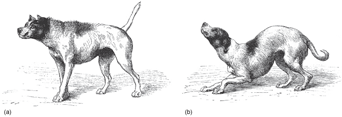2.1 An evolutionary approach to emotion in humans and animals
The evolutionary approach suggests that non-human animals, our evolutionary relatives, experience emotions too. Anybody who has a pet dog or has observed any animals carefully should need no convincing of this! Charles Darwin was one of the first to study the expression of the emotions in animals and humans systematically (Darwin, 2009 [1872]). Figure 2 shows a dog expressing two rather different emotions – aggression and fearfulness (or submission).
Activity 1 Identifying features of different emotions
Look carefully at the two pictures of the dog and list the main differences you can see between the aggressive and the fearful postures.
Answer
The position of the ears, the tail and the height of the body are all different. The aggressive dog stares straight ahead; the submissive dog does not. The hairs on the back of the aggressive dog are raised. You may have noticed other differences too.
It is striking how different the postures are. Indeed, diametrically opposite emotions appear to have evolved features that make it very easy to tell them apart. Similarly, a happy face is normally easy to distinguish from an angry one. Such features suggest that the expression of emotions has an important function in social communication – for instance, in letting others know how we feel and what the consequences, pleasant or unpleasant, might be if they approach us.
A consequence of the evolutionary heritage we share with other animals, in particular mammals such as rats, and even more so, monkeys and apes, is that there is significant similarity in the biological bases of many of our emotional response systems, as you will see in Sections 2.3 and 2.4.
The evolutionary approach also suggests the universality of human emotions – an idea again first clearly espoused by Darwin (2009 [1872]). This is the idea that all human races and cultures experience similar emotions, such as sadness, anger and joy. This has not always been accepted, which is not surprising, as cultural differences amongst humans have created strikingly different behaviours and displays of emotions in circumstances that appear otherwise comparable. A classic example is provided by cultural differences in the public expression of emotion at the death of a loved one. In traditional Japanese culture, weeping and wailing in public would be deemed scandalously uncontrolled and undignified. In others (such as traditional Indian culture), the absence of such behaviour might be deemed equally scandalous – signifying a lack of feeling for, and attachment to, the deceased.
Differences such as these led to the assumption that people in different cultures did not feel the same emotions, or did not feel them in the same way (e.g. Bruner and Tagiuri, 1954). However, there is convincing evidence of the universality of basic human emotions.

